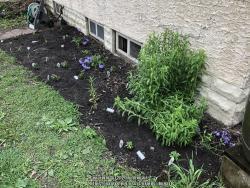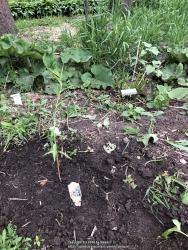Posted on May 23, 2020 1:51 PMFirst Things First: What Got Done
Since my last post, I finished clearing the East bed. Here it was before I started:

You can see the garden hose reel at the far end, and the New England Aster on the right side. That light yellow thing is an old metal lawn chair which had its tubular legs fold over. We have to take it to metal recycling.
But the key thing is that there wasn't anything special planted there. The white flags are part of a one-yard grid I put in place so I could map out planting areas and such for my original set of plants. In fact, you can see some of the newly-purchased plants in the lower-right of the image.
Here's how this area looked yesterday, after I cleared out all the weeds over the past couple of weeks:

This is from a different angle. The hose reel is cut-off on the left edge. The New England Aster is still on the right side; this is new growth from 2020, with the dead 2019 stems pruned away. I hadn't graded the soil, yet, but I was essentially ready to buy plants for this bed.
And this is how it looks today:

The plants are in place, and I've put the metal markers out. Some of the plastic ones I kept next to the plants, but the squirrels like to dig them up. I will probably end up doing one metal marker per plant, so I have no confusion next spring about which new growths are my perennials.
But...I got it done. And I have to say, it felt really good to have the bed all ready when I went shopping for plants. I was sorely tempted when I saw other plants on my list for the future, but I was good, and only bought what I was ready to put in the ground. The only exception was another Swamp Milkweed, because I had that area by my existing one:

I have to do some serious weeding in this area, but it was practically open where I put the new plant.
So, let's talk about how I decided what to put in here.
The Master List
Remember my goal: to put in native plants to attract wildlife to my yard. To keep birds and pollinators coming to the yard means having plants which bloom throughout the season. In Minnesota, that could be as early as March, and as late as October. I didn't have any plants which bloom in the early spring, to provide overlap with the plants which bloom in late May or early June. I need to fill that gap.
Another thing I want to do is plant all around my house, even the north side, which doesn't get direct sunlight. So I need to find more shade-loving plants that can occupy those spaces. As it happens, many of the spring ephemerals in Minnesota grow on forest floors in the shade, so I will likely be able to attract more early-spring pollinators and fill the shady spots.
Also, I want to provide more hummingbird-attracting plants. I had two species last year. The Large-Flowered Beardtongue, penstemon grandiflorus, didn't seem to do much beyond one stem and a couple of flowers; I'm not even sure if it will grow back this year, yet. I also planted four Wild Bergamot plants, monarda fistulosa, but they were so small last year that they didn't do much. They are much bigger so far than they ever were last year, so we'll see if they bloom.
I spent some time reviewing my books, handouts from the local bird-feeding store, and e-mail exchanges with my native-plant-savvy neighbor, and came up with a list of plants to get. Here we go...
- Agastache foeniculum, Blue Giant Hyssop: attracts birds and bees (Just Planted!)
- Amelanchier interior, Inland Serviceberry: This is the actual Minnesota-native plant; I'd like to get it to go with my existing Apple Serviceberry
- Amelanchier x grandiflora, Apple Serviceberry: I'd get another if I can't get the Inland Serviceberry; both provide food for birds
- Anemone patens/pulsatilla patens, American Pasqueflower: The only blooms-in-March one I could find that's got a chance in my yard
- Aquilegia canadensis, Red Columbine: Attracts hummingbirds
- Asclepias incarnata, Swamp Milkweed: I already have one, but I'd like to provide more Monarch habitat (Just Planted!)
- Baptisia bracteata, Plains Wild Indigo: A rare-in-Minnesota plant that grows well in gardens, and blooms in May
- Baptisia lactea (or b. alba), White Wild Indigo: Another rare-in-Minnesota plant that grows well in gardens (Just Planted!)
- Cardamine concatenata, Cutleaf Toothwort: Like partial shade and attracts butterflies; blooms in April
- Claytonia virginica, Virginia Spring Beauty: Attracts bees and blooms in April
- Clematis virginiana, Virgin's Bower: A clematis that also attracts bees
- Cornus sericea, Red-Osier Dogwood: I already have one, but I want more because birds will eat the berries
- Dicentra cucullaria, Dutchman's Breeches: Attracts bees, loves shade, blooms in April
- Diervilla lonicera, Bush Honeysuckle: Attracts hummingbirds, bees, birds, and butterflies
- Geranium maculatum, Wild Geranium: Likes the shade, and attracts bees
- Geum triflorum, Prairie Smoke: Attracts bees and blooms in April
- Hydrophyllum virginianum, Virginia Waterleaf: Saw this on a PBS gardening show; attracts bees and likes shade
- Liatris cylindracea, Cylindric Blazing Star: Attracts bees and butterflies
- Liatris punctata, Dotted Blazing Star: Also attracts bees and butterflies, and likes partial shade (Just Planted!)
- Lobelia cardinalis, Cardinal Flower: A prime hummingbird attractor
- Lobelia siphilitica, Blue Lobelia: Another hummingbird attractor
- Mertensia virginica, Virginia Bluebells: Shade-loving and blooms in April
- Penstemon grandiflorus, Large Beardtongue: I planted this last year, and had blooms, but I haven't seen it come back yet; hummingbirds like it
- Phlox divaricata, Wild Blue Phlox: Shade-loving, and blooms in April (Just Planted!)
- Phlox maculata, Wild Sweet William: Attracts hummingbirds
- Phlox pilosa, Prairie Phlox: Attracts hummingbirds, and blooms in May
- Ribes americanum, Wild Black Currant: Good for birds, bees, and butterflies
- Rosa blanda, Smooth Wild Rose: Good for birds and bees
- Salix humilis, Prairie Willow: This is a bush, not a tree, but attracts birds and bees and blooms in April
- Solidago flexicaulis, Zigzag Goldenrod: Good for bees and butterflies, and likes the shade
- Solidago nemoralis, Gray Goldenrod: Good for bees and butterflies, but wants the sun
- Uvularia grandiflora, Large-Flowered Bellwort: Good for bees, likes shade, and blooms in April
- Viburnum opulus v. americanum, American Highbush Cranberry: Provides berries that persist into winter that birds will eat
- Zizia aurea, Golden Alexanders: Attracts bees and butterflies
One weekend should take care of all that, right?
Are You Sure You Want to Plant All That?!
Not all at once! I was joking about one weekend; this is part of a multi-year plan. I don't even know where these plants are all going to go at this point.
What I wanted to do with this list was to identify plants that will fill my needs: work in the shade, attract the critters I want, bloom in the spring. By knowing details about them -- how much watering, soil pH requirements, etc. -- I can start figuring out what should go where, and when I clear a given section I know what I can purchase and put in the ground. If you read my previous blog entry (
Planning May Mean Thinking About Next Year, Right Now), you know that it is easy to over-extend yourself; I can easily bite off more than I can chew. The secret isn't to dream small, but to plan big...and, long-term.
Think about all the stuff you want to do, then think about what you could do in a year, then in a season, then in a month. Once you have that idea, use it for the current year. If you get more time, you have more tasks you can do; but the goal is to have something achievable. See what I did with my East planting bed, above, as an example. If I do nothing else this year but clean up borders and weed, I've got something I achieved.
Garden SMART!
I work in a corporate job (even though my "desk" is now in my basement due to the pandemic), and one of the things that's been talked about for years is that whatever goals you set should be SMART. The acronym stands for the following points:
- Specific. Be clear and detailed about what your goal is. I didn't say "do weeding," I said "Clear the weeds from the East planting bed."
- Measurable. You have to have some metric, rather than something like "get better," which is pretty vague. For me, clearing the weeds is easily measurable, I know when I'm done.
- Attainable. This is something you can actually do. You have the skills and the tools you need.
- Relevant. In a corporate job, this means it aligns to your organization's mission. In a home garden, keep gardening goals focused on gardening. For instance, I'm not thinking about reconditioning the lawn, or getting outdoor furniture, as part of my "garden work."
- Time-Based. There's a clear dead-line.
This stuff isn't new; even my teenage son has worked with SMART goals for years. But it may not be something you've thought of applying to gardening.
I think you will be happier if you can actually finish something, so break up the things you want to do into pieces that you can get done. I know I feel better when I do.
Now, I have to get back to pruning my grape vine, as we're supposed to take delivery of pieces of a custom-built arbor today!



